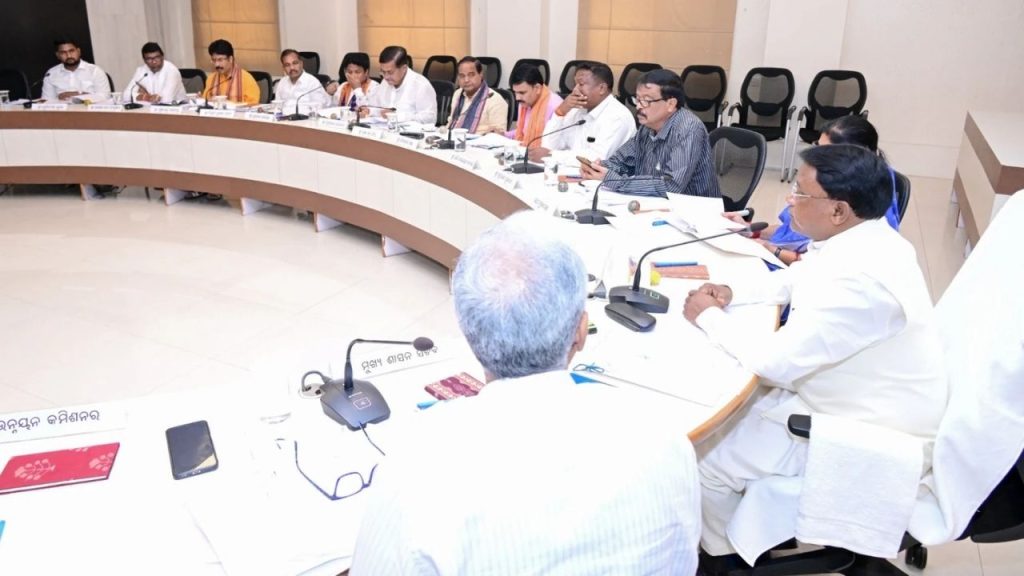Odisha, a state on the eastern coast of India, is undergoing a major transformation that could reshape the way it functions. A recent game-changing bureaucratic shuffle, with new appointments and transfers of high-ranking officials, is sparking conversations about the state’s future. This reshuffle includes the transfer of 49 senior IAS officers, changes within the Forest Department, and leadership overhauls in higher education. These developments are set to make waves across administrative, industrial, and educational landscapes, potentially changing the state forever.

The state government’s strategic approach to governance has led to this reshuffle, which not only places experienced professionals in key roles but also injects fresh energy with the induction of younger officials. This article breaks down the reshuffle and provides insights into how these changes will impact Odisha in the short and long term.
Odisha’s Game-Changing Bureaucratic Shuffle
| Topic | Details |
|---|---|
| Number of Officers Transferred | 49 senior IAS officers |
| District Collectors Affected | 16 districts |
| Key Appointments | Sanjeeb Kumar Mishra, Hemant Sharma, Roopa Roshan Sahoo |
| OFS Reshuffle | 34 officers transferred in the Odisha Forest Services (OFS) |
| New Industrial Security Force | 2 battalions formed for industrial security |
| Youthful Leadership | 9 young IAS officers appointed as sub-collectors |
| Utkal University Change | In-charge VC appointment canceled |
| Official Reference Link | Times of India |
Odisha’s recent bureaucratic shuffle is not just a routine change; it’s a bold step toward a more efficient, effective, and sustainable governance system. From reshuffling top officials in the finance and education sectors to implementing significant changes in industrial security and the forest services, these moves are all geared toward shaping the future of the state.
This reshuffle holds the potential to transform Odisha’s administrative landscape, creating an environment conducive to growth, development, and enhanced service delivery. By strategically placing experienced leaders and empowering younger officers, Odisha is setting the stage for a promising future.
The Importance of a Bureaucratic Reshuffle
Bureaucratic reshuffles are often seen as an indication of new directions, and in Odisha’s case, this shuffle could mark a significant shift. With administrative efficiency at the forefront of the government’s goals, reshuffling officers is often necessary to ensure the right leadership in the right places.
While many might think that such changes are just about moving people around, they often go much deeper. These changes are about creating systems that work better, faster, and more effectively for the people of the state. Odisha’s reshuffle, in particular, is set to make a lasting impact due to the sheer volume of officers being transferred and the critical positions they now occupy.
Let’s dive into the specifics.
The Power of Transfers: Why This Bureaucratic Shuffle Matters
Bureaucratic reshuffles, like the one Odisha is witnessing, are essential for a state to stay adaptable in times of change. New appointments and transfers ensure that people with fresh ideas and new energy are in leadership roles. For example, Sanjeeb Kumar Mishra has been appointed as Principal Secretary of the Finance Department. His background in managing the state’s finances is crucial for implementing reforms aimed at improving Odisha’s economic landscape.
The reshuffle isn’t just about putting new people in charge; it’s also about breaking down silos between various departments. Hemant Sharma, who was the Additional Chief Secretary of Industries, is now heading the Information and Public Relations Department. This move signals a concerted effort to strengthen the link between industry and media outreach.
A New Vision for District Leadership
District leadership plays a crucial role in how efficiently a state functions on the ground. District collectors are key players who oversee the administration, development, and welfare of the people in their areas. In Odisha, 16 districts have new district collectors, bringing in fresh perspectives and approaches.
One of the key objectives behind these transfers is to strengthen governance at the grassroots level. The new appointments focus on not just administrative experience but also an ability to think creatively and solve complex problems. Youthful leadership, such as the induction of nine young IAS officers as sub-collectors, is seen as a move to bring in dynamic energy and a fresh outlook on governance.
The Forest Department Overhaul: A Step Toward Sustainable Development
One of the significant changes in the reshuffle has been in the Department of Forest, Environment, and Climate Change. This sector is crucial for maintaining the ecological balance and sustaining natural resources in the state.
Kshama Sarangi, a key officer in this department, has been promoted to Principal Chief Conservator of Forests and Head of the Forest Force. Her role is pivotal in managing Odisha’s vast forests, home to numerous species and important ecosystems. Furthermore, Debarchan Behera and Binod Acharya have been appointed as Divisional Forest Officers in Nayagarh and Chandaka (Wildlife), respectively.
This reshuffle within the Odisha Forest Services (OFS) is about reinforcing the state’s commitment to sustainability. The state has some of India’s most important national parks and wildlife sanctuaries. Efficient management of these resources requires experienced leadership, which the reshuffle aims to provide.
Utkal University Leadership Change: Legal Hurdles and Reforms
Another interesting development resulting from this reshuffle is the cancellation of the appointment of Jagneshwar Dandapat as the in-charge Vice-Chancellor of Utkal University. This move came after a public interest litigation challenged his appointment, arguing that it violated the Odisha Universities Amendment Act, 2024.
This action reflects the government’s determination to uphold legal frameworks and ensure that appointments are in line with statutory requirements. Moreover, the state plans to amend the Act to allow the appointment of any qualified individual as interim head, without necessarily being a sitting VC.
The situation surrounding Utkal University demonstrates that bureaucratic reshuffles aren’t always smooth. However, they often bring about necessary reforms that can lead to improved governance in the long run.
Strengthening Industrial Security in Odisha: New Battalions
With Odisha emerging as a leader in steel and aluminum production, the demand for industrial security is on the rise. The state’s growing industrial zones, particularly in the 480 km coastline, are becoming critical hubs for economic development. To address security challenges, the government announced the creation of two new battalions under the Odisha Industrial Security Force (OISF).
These battalions will play a critical role in safeguarding industrial areas, ensuring the security of workers, and preventing industrial espionage or sabotage. This move not only enhances security but also demonstrates the state’s commitment to fostering a safe environment for industrial growth.
Odisha’s 49 IAS Officers Transferred in Sweeping Reshuffle – Are These Districts Ready for Change?
Odisha DFO Under Scrutiny After Rs 50 Lakh Deposits Detected in Accounts
Mukhyamantri Bus Seva to Launch in Kotia Soon, Announces Odisha Minister Bibhuti Jena
FAQs
1. What is the main goal of this bureaucratic reshuffle in Odisha?
The main goal of this reshuffle is to improve governance by placing experienced and dynamic leaders in key positions. The changes are designed to enhance administrative efficiency, strengthen industrial security, and promote sustainable development, particularly in the areas of education, environment, and industry.
2. How will the reshuffle affect the day-to-day lives of people in Odisha?
While these changes might seem internal, they will have a significant impact on the ground. With new leadership in districts, the government hopes to improve service delivery, solve local issues more efficiently, and respond to the evolving needs of the people. This could result in better infrastructure, improved public services, and more streamlined administration.
3. Who are some of the key people involved in this reshuffle?
Some of the key figures in this reshuffle include Sanjeeb Kumar Mishra (appointed as Principal Secretary of Finance), Hemant Sharma (now heading the Information and Public Relations Department), and Kshama Sarangi (promoted to Principal Chief Conservator of Forests).
4. How are young officers contributing to this reshuffle?
The government has appointed nine young IAS officers as sub-collectors, which is a strategic move to infuse fresh energy and innovative ideas into local governance. These young officers bring dynamic leadership to the districts, which is expected to help tackle complex issues with a fresh perspective.
5. Will the industrial security changes impact Odisha’s economy?
Yes, the formation of two new OISF battalions will enhance security in industrial zones, contributing to a more stable environment for growth. As Odisha continues to be a hub for industries like steel and aluminum, ensuring the security of these areas is crucial for economic growth and investor confidence.





